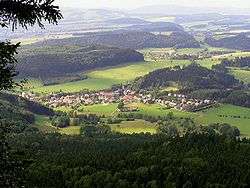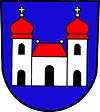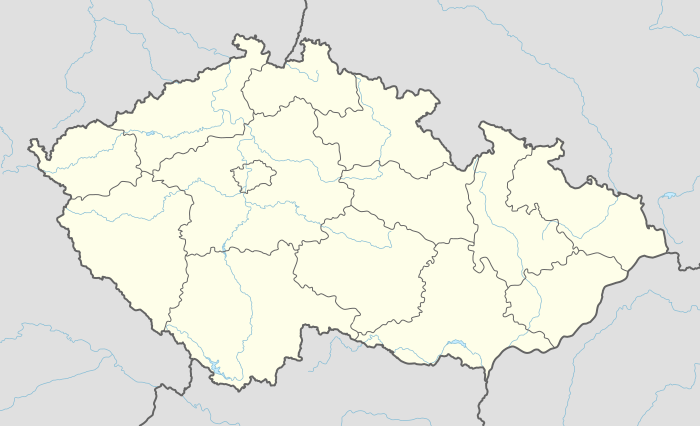Machov
Machov (German: Machau) is a market town situated in the Czech Republic and in the Hradec Králové Region. It has around 1,100 inhabitants.
Machov | |
|---|---|
Market town | |
 Machov – view from Poland | |
 Flag  Coat of arms | |
 Machov Location in the Czech Republic | |
| Coordinates: 50°29′20″N 16°16′14″E | |
| Country | |
| Region | Hradec Králové Region |
| District | Náchod District |
| Time zone | UTC+1 (CET) |
| • Summer (DST) | UTC+2 (CEST) |
Geography
It lies just next to the border with Poland. Machov has always had a majority of Czech inhabitants although strong ties with Polish and German borderlands existed. Machov originally lay entirely on a left side of the brook Židovka but it was later merged with other villages, now administrative parts of Machov. Nízká Srbská on the right hand side of Židovka, Machovská Lhota further along the brook and also Bělý. Machov lies in a valley of the brook Židovka and under a dominant mountain Bor, which is one of the famous Table Mountains in Poland. Close to Machov are also Broumov Cliffs, which are sandstone towers perfect for rock climbing.
Near Machov, there are important resources of drinking water thanks to a geological substratum that filters rain water. The same minerals also formed amazing sandstone rock towers of already mentioned Broumov Cliffs and Table Mountains.
History
The first written note is from 1354 and the first note of Machov as a market town is from 1405, when it was a part of Náchod county. A church of St. Wenceslas[1] from 1675 stands at the place of a removed wooden church established in 1354. There is a baroque Marian column on the square from 1761. A protected lime tree (Tilia cordata) with estimated age of 500 years grows near house number 26. It is the oldest tree in the whole region and the specimen is a national emblem of the Czech and Slovak republic.
International relations
References
- Wenceslaus I, Duke of Bohemia
External links
| Wikimedia Commons has media related to Machov. |
- Official website (in Czech)
- Broumov Cliffs (in Czech)